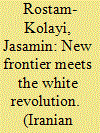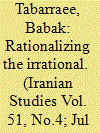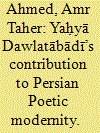|
|
|
Sort Order |
|
|
|
Items / Page
|
|
|
|
|
|
|
| Srl | Item |
| 1 |
ID:
160284


|
|
|
|
|
| Summary/Abstract |
Qianling Mausoleum (乾陵) which is located in the northwest of Xi'an, is the tomb of Emperor Gaozong of the Tang Dynasty (唐高宗, r. 649–83 AD) and his Empress Wu Zetian (武則天, r. 690–705 AD). In this mausoleum, there are two statues of Pērōz, son of Yazdegird III (632–51 AD), and another Persian nobleman who have been recognized by western scholars. However, scholars’ attention has been limited to a general and mistaken description of the statues. This paper reassesses both statues in order to give some new insight into the head of one of the statues found at the Qianling Mausoleum.
|
|
|
|
|
|
|
|
|
|
|
|
|
|
|
|
| 2 |
ID:
160285


|
|
|
|
|
| Summary/Abstract |
This article is a review of the afterlife, or Nachleben, of the romance Vis and Rāmin, one of the first representatives of its genre in New Persian literature. In addition to providing readers with an extensive bibliography of sources and research concerning the poem, it also analyzes these materials to put forward two basic arguments: one, that moral or religious antipathy to the poem’s contents may not have played as great a role in its fortunes as did aesthetic taste; and two, that V&R proved to be a more widely circulated and durable work than is commonly supposed, but on the level of fragments, not the entire text. In light of these arguments, it is proposed that studies structured around the comparison of fragments—themes, ideas, ethics, and motifs, rather than whole texts—may offer more purchase in constructing models of analysis that situate V&R, and Persian literature more broadly, within a literary oikumene in which it connects and interacts with neighboring traditions.
|
|
|
|
|
|
|
|
|
|
|
|
|
|
|
|
| 3 |
ID:
160287


|
|
|
|
|
| Summary/Abstract |
The Peace Corps brought an estimated 1,800 Americans to Iran from 1962 to 1976, coinciding with the unfolding of Mohammad-Reza Shah Pahlavi’s Enqelāb-e Sefid, or White Revolution. This article surveys Peace Corps Iran’s fourteen-year history by dividing it into three distinct moments defined by changing social and political conditions in Iran and shifting US‒Iranian relations. Initially, the Peace Corps Iran experiment built on earlier American foreign assistance programs, while coinciding with the roll-out of the White Revolution. Second, during its heyday in the mid-1960s, the Peace Corps inevitably became entangled with the White Revolution’s unfolding, both experiencing a phase of expansion and apparent success. Finally, as Iranian social and political conditions moved toward instability by the 1970s, Peace Corps Iran also seemed to have lost its direction and purpose, which ultimately led to a vote by volunteers to terminate the program. Based on accounts by US Peace Corps volunteers and the Iranians with whom they worked, the Peace Corps Agency, and the US State Department, this article argues that, ultimately, the Peace Corps Iran experience left a more lasting legacy on individuals than institutions.
|
|
|
|
|
|
|
|
|
|
|
|
|
|
|
|
| 4 |
ID:
160288


|
|
|
|
|
| Summary/Abstract |
Reza Attaran is one of the most successful stars of the Iranian popular cinema. This article explores the social circumstances, performative components, and political consequences of Attaran’s popularity and stardom, and the evolution of comedy and satire in the Iranian media after the 1979 Revolution. Analyzing the contextual elements and media texts over the last twenty-five years, the article argues that Attaran actively reflects a complex interaction between the social, political, and artistic demands of each period, best represented through his contribution to the television sketch comedies in the 1990s, and the lowbrow comedies and highbrow absurd films in the 2010s. The trajectory of Attaran’s stardom demonstrates the mechanism by which he serves the maintenance of the status quo.
|
|
|
|
|
|
|
|
|
|
|
|
|
|
|
|
| 5 |
ID:
160286


|
|
|
|
|
| Summary/Abstract |
In 1912, Yaḥyā Dawlatābādī composed two poems, the form of which diverged greatly from the canonical rules of tradition. Both poems were based on syllabic meters. Critics and historians of modern Persian literature have given these poems little consideration, and discussed them merely from the point of view of metrics. When compared to the great modernist endeavors in the poetry of the time, these pieces were judged severely, or altogether disavowed. This paper aims to show that, beyond mere metrical audacity, Yaḥyā Dawlatābādī’s syllabic poems were in fact innovative. As the article argues, they were born out of the same quest for fresh poetic forms that induced contemporaneous modernists to create new, individualized poetic patterns.
|
|
|
|
|
|
|
|
|
|
|
|
|
|
|
|
|
|
|
|
|